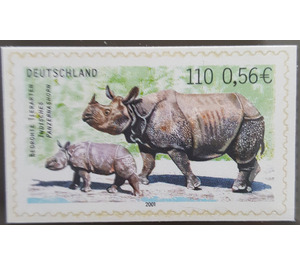Endangered species - self-Adhesive - Germany / Federal Republic of Germany 2001 - 110 Pfennig
Theme: Animals
| Country | Germany / Federal Republic of Germany |
| Issue Date | 2001 |
| Face Value | 110.00 |
| Perforation | wavy cut |
| Printing Type | offset |
| Stamp Type | Postage stamp |
| Item Type | Stamp |
| Chronological Issue Number | 2078 |
| Chronological Chapter | GER-BRD |
| SID | 288259 |
| In 23 Wishlists | |
The series "Endangered Species" aims to raise public awareness of the protection of endangered species. The Indian rhinoceros is one of the five rhino species still living on Earth today. While it used to live in southern Himalayan territory from present-day Pakistan to Myanmar in ancient geological times, today it only lives in a few national parks in India and Nepal. Thanks to these conservation reserves, the number of rhinos worldwide has increased from less than 100 animals to more than 2,000. Nevertheless, the animals are endangered. Poachers hunt them mainly for their horns. The highly valued horn in traditional Asian medicine horn substance is now more valuable than gold. In addition, the pressure of the rural population to use the limited areas of the protected areas for agricultural purposes is growing.



